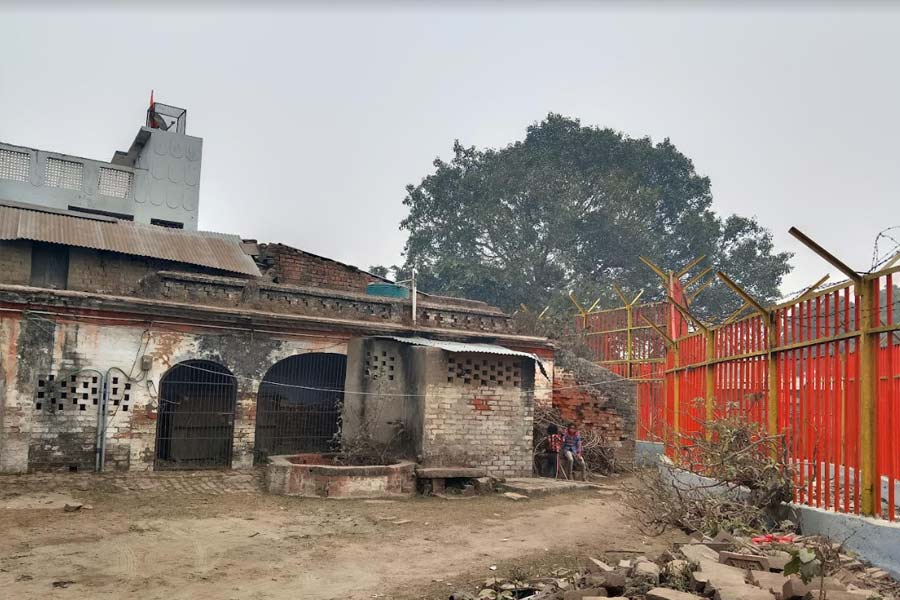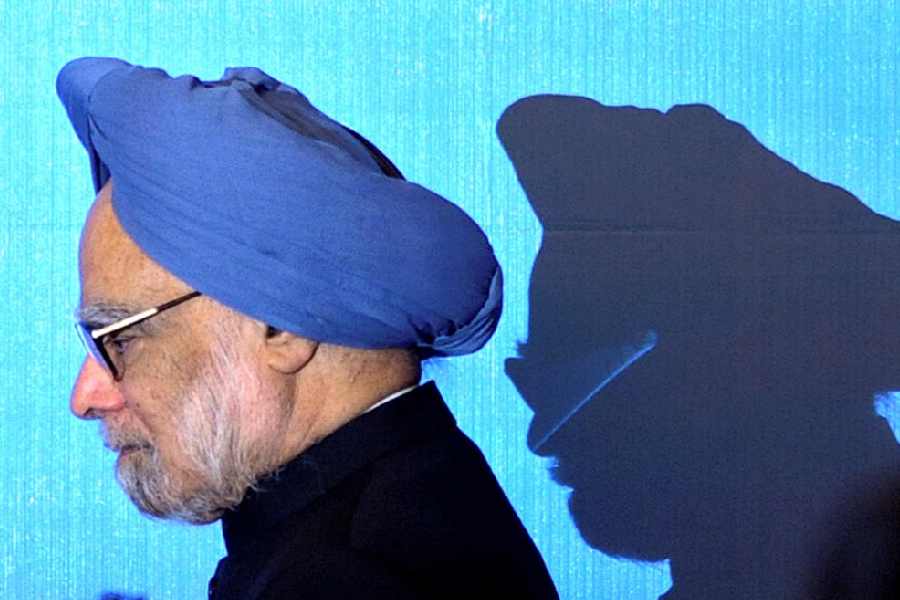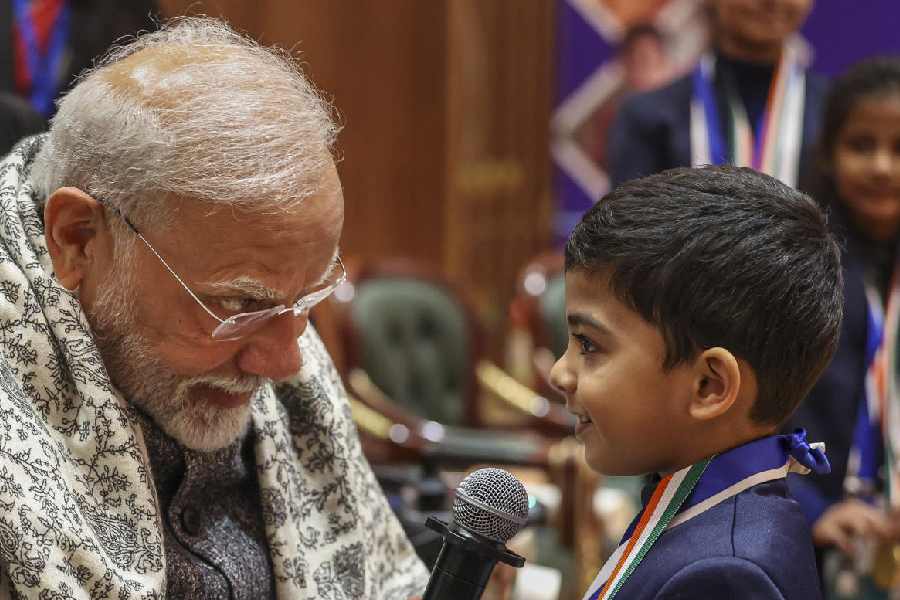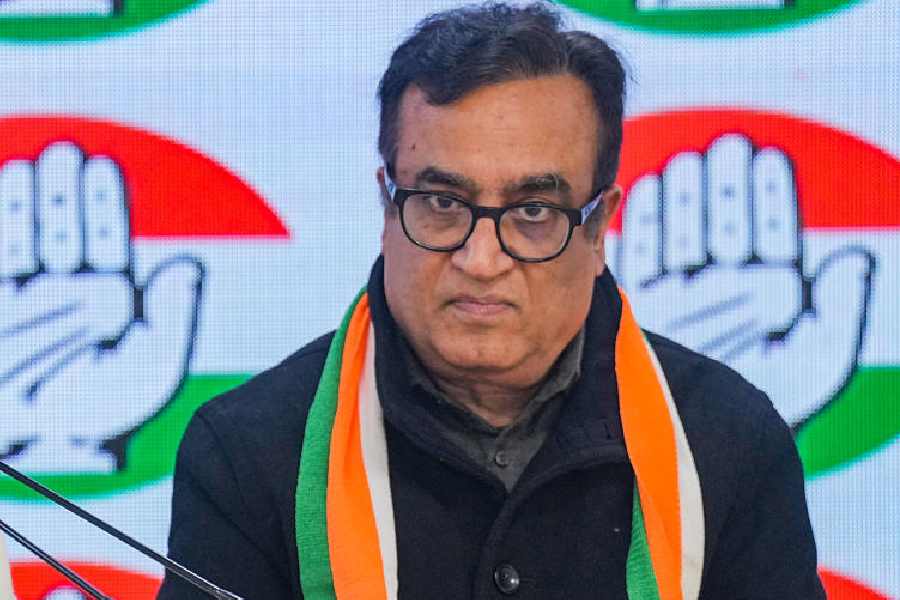Fifty-year old Vineet Maurya is afraid of losing his home adjacent to the boundary wall of the new Ram temple that is being built in Ayodhya. In his ever-unfolding story, which started somewhere in the late 1980s, lies an extraordinary tale. A tale that defines the India and the Ayodhya of today.
Around 1988¬-89, the Uttar Pradesh government paid Rs 1 per square feet as it acquired 52.90 acres of land for the construction of a Ram Katha Park, that included 11 acres of farmland owned by the Maurya family.
Thirty-six years later, a day after Prime Minister Narendra Modi’s dazzling performance at the pran-pratishtha (consecration) of the idol of Ram Lall at the under-construction temple in Ayodhya, a beaming Amitabh Bachchan appeared on full-page advertisements for Sarayu, a residential project developed by the Mumbai-based House of Abhinandan Lodha, overlooking the river of the same name and 15 minutes from the temple. The starting price of a 1,250 sq feet plot, said the ad, was pegged at Rs 1.72crore.

Amitabh Bachchan promoting Sarayu, a seven-star mixed-use enclave coming up near the Airport.
Not since 1764, when Shuja-ud-Dowlah, the third Nawab of Oudh or Awadh (derived from Ayodhya) built Chhota Calcutta, the first fort at Faizabad (34 years after it was made the capital of the kingdom), has the region seen this level of construction activity. Mythology and history are as intertwined in the region as are Ayodhya and Faizabad. Nobody can quite say for sure where Faizabad ends and Ayodhya begins.
Today, Ayodhya is on a modernity overdrive, projecting a mythological identity while Faizabad is being gradually erased. In November 2018, the name of the district was officially changed from Faizabad to Ayodhya. The tehsil, the local civic body, the international airport, the railway station all bear the name Ayodhya or Ayodhya Dham, considered among the holiest of cities for believer Hindus.
Even the new city being planned, for which the government has already acquired 1,407 acres, and is in process of acquiring an additional 450 acres, has been named Navya Ayodhya. For this new Ayodhya, near the newly built international airport, land has been acquired from Ayodhya itself, as well as from the adjoining districts of Gonda and Basti, across the Sarayu. The Uttar Pradesh government has decided to inject Rs 85,000 crore into Ayodhya until 2031. In the current fiscal, UP’s debt burden is estimated to reach Rs 7.84 trillion, 14 per cent higher than the annual budget of the state.
The revenue figures from Ayodhya seem to back the UP government’s excitement over the “development” planned in the area. According to officials in the district administration, revenue from the registry of land has witnessed a hike from 32,549 properties/land deals in 2018-19 to 45,630 in 2022-23.
The English are known to make hay while the sun shines. In North India, people prefer “behti ganga mein haath dhona.” In Ayodhya, they have the Sarayu or Ghaghara rivers. For centuries, residents used to the slow pace of life, have taken a leap of faith to make the most of the present regime’s fixation over Ayodhya and are trying to change their fortunes using the only currency in their possession: land. Some have struck gold, others like Maurya are either on the brink or have already lost their livelihoods.
Local residents claim land prices have rocketed since the 2019 Supreme Court verdict which favoured construction of a Ram Temple. The temple has now come up close to where the Babri Masjid stood till December 6, 1992. A square foot of land that once fetched anywhere between Rs 600 to Rs 3,000 even five-six years ago is now as high as ₹15,000.
Land within 5km of the temple site was up for grabs even before the 2019 verdict. Buyers included MLAs, relatives of serving bureaucrats and police officers. The buzz in Ayodhya is that one of Hindi cinema’s biggest superstars paid around Rs 11 crore for a plot, the location of which, possibly within Sarayu, is as closely guarded a secret as the plot of any big ticket film.
“We have heard businessmen from Gujarat, Maharashtra and Tamil Nadu have purchased land here,” says a resident of Amaniganj, Faizabad. Local residents and outsiders are both looking for land in Ayodhya, which now costs a premium, even higher than those around the state capital Lucknow. So is the Ram Janmabhoomi Teerth Kshetra, the trust involved in the construction of the temple.
“Most of the big temples in Ayodhya have now been bought by the trust. Nobody knows exactly where and when the trust is going to stop (its expansion plans),” says Anil Singh, who teaches Hindi literature at the Kamta Prasad Sundar Lal Saket PG College.
The trust started its expansion programme in 2021 when it bought three of Ayodhya’s oldest temples in the Ramkot area falling within the upcoming temple complex --- Kaushalya Bhawan and Fikerah Ram Mandir --- at a combined cost of Rs 7.70 crore and Deen Kuti Mandir along with alternate land. Similar “negotiations” were also held with individual house owners.
“Where the trust is involved, the owners are getting money. If the government steps in there is little in terms of compensation,” says Singh, who has lived in Faizabad for 22 years.
Houses, shops, places of worship were subjected to some degree of demolition for the construction of Rampath, one of the main thoroughfares that starts from Shahadatgunj in Faizabad and ends at the temple, and many of them allegedly received paltry compensation. “The owners got Rs 50,000-Rs 1 lakh, while the places of worship got between Rs 8 lakh-Rs 10 lakh,” says a resident of Lakshmanpuri.
After Ramkot, the trust has set its eyes on Dorahi Kuan, Kajiana, Sutahati and Alamgunj Katra areas, all with a sizeable Muslim population. Last October, two local residents were accused of selling a mosque at Badr Mohalla Panji Tola under the Sunni Waqf board in Ayodhya for Rs 30 lakh.
Atul K Singh, whose family has lived in Faizabad close to a century, says Dilli Darwaza, was where jewellers and rich traders of the town had their homes for generations. So narrow are the roads that even two cars can’t pass each other. People who lived there for generations have now started to move out to more open spaces,” says Singh.
A member of the Communist Party of India till about a decade ago, Singh’s name will be etched in Ayodhya’s history forever for a different reason. Last August, he gave the town its first mall and multiplex, the Mall of Avadh in Niyawan (Faizabad). The multiplex, “Dhishoom”, opened on September 21, one day less than four months before the event in the temple town.
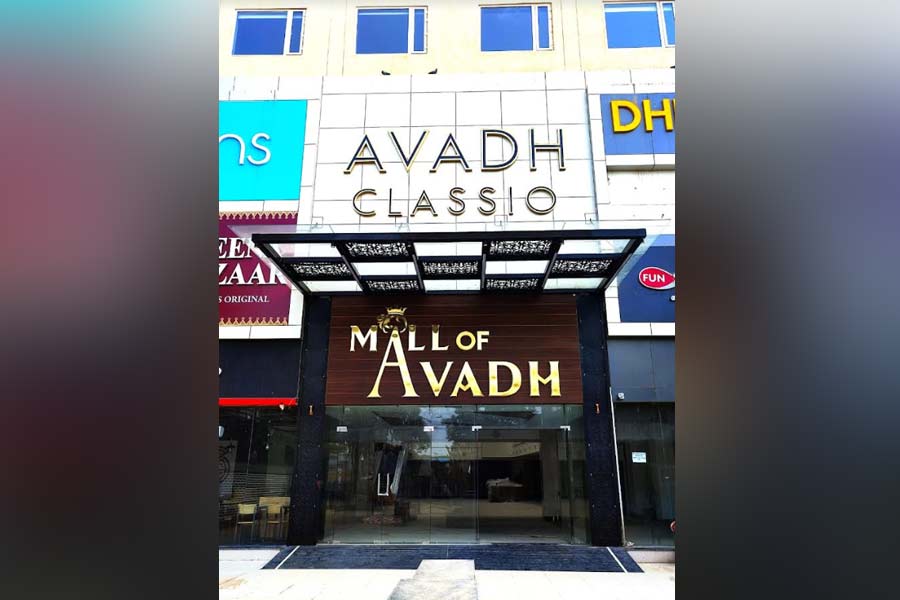
Ayodhya's first mall the Mall of Avadh.
The Ayodhya Development Authority website has a list of 17 housing projects, of which 14 are in various localities of Faizabad. On the page listing available properties, it says in Hindi: “Vartaman mein koi sampatti bikri ke liye upalabdh nahin hai (No property no property is available for sale now).”
Indraneel Dasgupta, who teaches economics at the Indian Statistical Institute (Calcutta) describes the heightened real estate activity in Ayodhya as “speculative boom”.
“People are expecting an explosion in tourism after the Ram temple, and so a large expansion in hotels etc. Now whether that will actually be the case or whether the boom will prove to be short-lived remains to be seen,” says Dasgupta. Jefferies, the international brokerage firm forecasts Ayodhya’s tourist footfall at 50 million-plus annually following the temple’s opening.
Forty-eight-year old Vishal Ganjoor quit his cushy job in the IT sector and returned to his hometown in Faizabad after spending close to 20 years in Australia and Singapore. At Faizabad's Amanigunj where the Ganjoors have their ancestral residence, a school used to run till the Covid pandemic.
In April 2023, Ganjoor started work on building a hotel. “By the time the Ayodhya verdict came in 2019, it was clear that the town would no longer remain the same. A windfall was clearly in sight. The government projections indicated that. A hotel seemed like a good investment,” says Ganjoor, the owner of “Maan Avadh”.
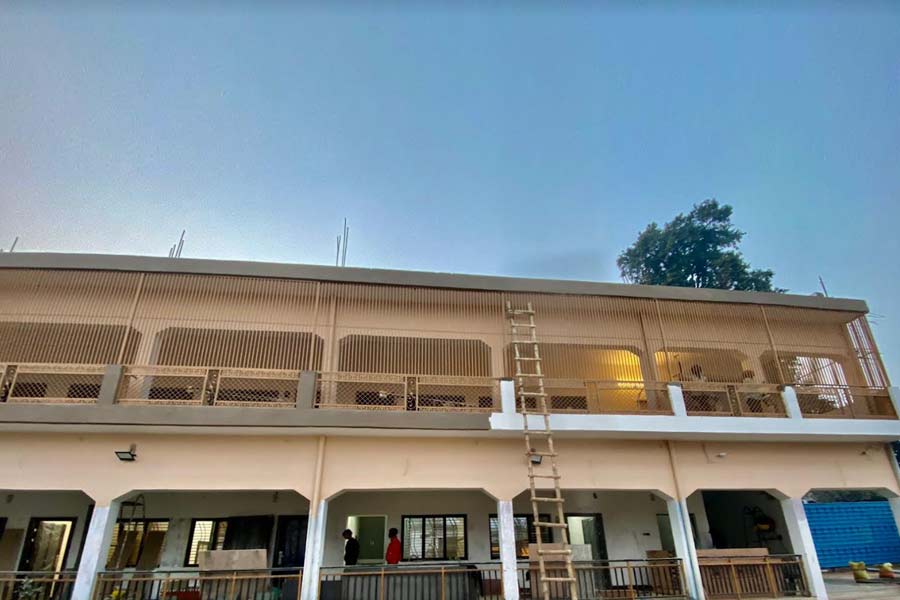
The under-construction Hotel Maan Avadh in Amaniganj, Ayodhya on Ram Path, the main road leading to the temple.
Just before the January 22 temple function, six rooms at “Maan Avadh” were opened and six more will be completed soon. “I have plans to add 12 more rooms,” he says. The hotel, not fully built just like the temple, ran to full occupancy coinciding with the gala inauguration.
According to the Ayodhya Masterplan 2031, the temple town barely had 592 rooms across 17 hotels and 70 dharamshalas. But that has changed now.
In the last one year or so, over 100 hotels and homestays have opened in the area. Lodha group’s Sarayu project, dubbed as a seven-star mixed-use enclave, will have an integrated 5-star hotel run by the Leela Group, which will also operate a clubhouse and over 30 amenities at the facility. Radisson Group has also entered into the fray. In December, the township got its first Tanishq showroom, the flagship jewellery brand from the Tatas.
There is a downside to the construction overdrive. “Many people, unaware of rules and regulations about construction, purchased plots. They are in a spot now as the rules restrict further constructions in some areas,” says Atul K Singh.
In mid-2022, the BJP’s Ayodhya MP, Lallu Singh, raised the issue of illegal construction in Devkali and submerged areas of Jamthara on the banks of Sarayu and demanded a probe by a special investigation team. Local reports stated houses, schools, colleges had come up in the submerged area between Jamthara to Golaghat on the banks of the Sarayu without sanction.
The question is how far the people of Ayodhya will be involved in its future. The temple complex area, now known as “yellow zone,” has already been segregated from the rest of the town. Even those staying in neighbourhoods around the temple have to carry a pass with them. But most local residents were kept away from the grand opening of January 22 that was attended by the who’s who of India.

The yellow zone pass is a must for the locals to move around the temple.
Behind the grand façade, the fresh coat of paint adorning the walls with Hindu religious symbols along the main thoroughfares, while the world watched glued to the television screen, the lanes and by-lanes wore an empty look. They still do.
Vineet Maurya, who does odd jobs for a living, has been waiting for a hearing to take place at the Faizabad court on his plot of farmland that lies behind the barricades where the Babri Masjid once stood. Today, Maurya is worried about losing his house where he lives with his brother and his brother’s wife and their two children. The house is at Kaziana Vashishth Kund and comes within the yellow zone, adjacent to the boundary of the under-construction temple.
“Ayodhya main khone jaa raha hoon (I am about to lose my Ayodhya). The government will any day acquire my house. Plots are being sold at Rs 10,000 per square feet. Somewhere in this new Ayodhya, if I could be given a place worth the land we lost and the house, will be enough for me,” says Maurya.
Ayodhya never had a Colaba or Jor Bagh or New Alipore. For centuries it was said every house in Ayodhya is a temple and every temple in Ayodhya a house. In seven years from now, Ayodhya could be just a gigantic temple complex with no homes.
Maurya’s only hope is that the trust reaches him before the administration.

A screengrab from the Ayodhya Development Authority website.

